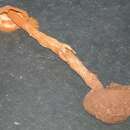Biology
(
Inglês
)
fornecido por Arkive
Fungi are neither plants nor animals but belong to their own kingdom. They are unable to produce their own food through the process of photosynthesis, as plants do; instead, they acquire nutrients from living or dead plants, animals, or other fungi, as animals do. In many larger fungi (lichens excepted) the only visible parts are the fruiting bodies, which arise from a largely unseen network of threads called 'hyphae'. These hyphae permeate the fungus's food source, which may be soil, leaf litter, rotten wood, dung, and so on, depending on the species.
Very little is known of the bizarre sandy stiltball fungus (2). The fruiting body is produced between September and November (5), either singly or in small groups (6). The stalk remains in place throughout winter, a feature that allows the presence of the species to be identified for a longer period (3).
Conservation
(
Inglês
)
fornecido por Arkive
Under Schedule 8 of the Wildlife and Countryside Act it is an offence to pick, uproot, cut, destroy, collect or sell any listed species. The sandy stiltball is one of just four species of non-lichenized fungi to receive protection under this schedule, furthermore it is a priority species under the UK Biodiversity Action Plan (UK BAP), and is included in English Nature's Species Recovery Programme. The Species Action Plan sets out the aims of maintaining and protecting current populations and promoting research into the ecological requirements of the species in order to inform habitat management (2). The hedge-bank in Suffolk is regularly monitored and is managed appropriately by the Suffolk Wildlife Trust (2).
Description
(
Inglês
)
fornecido por Arkive
This strange fungus has a small, rounded head borne on a shaggy ochre-brown stalk (1). The head is a mass of spores (3), which have a warty appearance and are brown and spherical (5).
WARNING: many species of fungus are poisonous or contain chemicals that can cause sickness. Never pick and eat any species of fungus that you cannot positively recognise or are unsure about. Some species are deadly poisonous and can cause death within a few hours if swallowed.
Habitat
(
Inglês
)
fornecido por Arkive
Found in very dry areas on sandy soils, on banks and at the edges of woods (5). It seems to be associated with decaying wood (6), and can sometimes be located inside hollow trees facing towards the light (2). It has been found in association with ash, yew and pine (7), and in Suffolk it is most often found under elm hedges (8).
Range
(
Inglês
)
fornecido por Arkive
Rare, usually a Mediterranean or Atlantic species (5), and has a scattered distribution in Europe. It has also been recorded from North America, Africa and Australia, but it may have been confused with another species (7). In Britain it is known mainly from the south and east of England (7); the best-known location is a hedgebank in Suffolk; at 70m in length, this site is thought to be Britain's smallest nature reserve (3).
Status
(
Inglês
)
fornecido por Arkive
Provisionally classified as Endangered in Great Britain (2), and fully protected in the UK under Schedule 8 of the Wildlife and Countryside Act 1981 (2). Digging up fungi without permission could also constitute theft under the Theft Act of 1968 (4).
Threats
(
Inglês
)
fornecido por Arkive
The hedge bank in Suffolk is known to have become overgrown in the past, and faces threats from road-widening and re-surfacing work (2). In addition the stumps of dead trees, which may provide valuable habitat for the species, are often removed (8).

